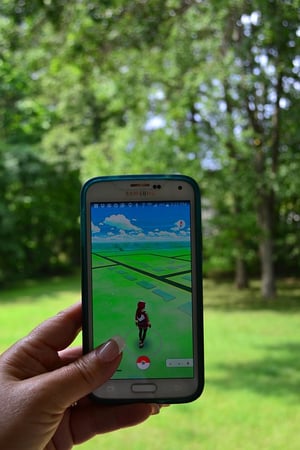Pokémon has always been a cute little children’s game, but the children who played the first ever Pokémon game on their Nintendo Game Boys in the late 90s are now in their late 20s and early 30s, and they belong to one of the largest generations ever, which had a combined global spending power of about $2.45 trillion in 2015 – the mysterious millennials.

The game that these millennials played as children has found its way back into their lives as technologically-savvy adults in the form of the augmented reality mobile game Pokémon Go, and it has exploded.
Pokémon Go was released in the United States and Australia on 6 July 2016, and by the 16th it had users in about 26 countries, and by the 19th the app had been downloaded approximately 30 million times.
Besides its resonance with Generation Y’s childhood, Pokémon Go is appealing for a number of reasons. In an article in the guardian, writer Leigh Alexander argues that in a world where technology forces us to confront catastrophes from all corners of the world wherever we are, it is only fitting that that same technology should give us a way to escape from the horrors that reality presents.
Unlike ordinary video games and mobile phone games, however, Pokémon Go does not seek to take its players out of reality, or create a whole new “virtual reality”, but instead presents players with an “augmented reality”.
Pokémon Go superimposes the classic game of catching Pokémon (a sort of abbreviation of “pocket monsters”) upon the real world. The basic premise is that players can wander about towns, cites and the countryside catching wild Pokémon using the game on their mobile phones. There are also PokéStops and Gyms around the world that allow players to perform additional actions and restock their in-game inventories (for more information check out Pokémon Go’s official website).
It is in the junction between the desire for escapism and the creation of a more exciting way to explore the world that Pokémon Go and the hospitality industry meet – they both cater to the same basic desires for fun, escapism and exploration. If you can embrace the similarities that augmented reality gaming and hospitality and tourism have with each other, there is a great opportunity to present patrons with exceptional experiences.
Recognise its significance
It might be hard to take a game where people wander around cities catching imaginary cartoon creatures in virtual balls on their mobile phones seriously, but Pokémon Go has more users than Twitter, and it has existed for less than a month. People are spending more time playing Pokémon Go than they are on Facebook, and, thanks to the fact that the app is built upon existing technology, it can be played anywhere in the world, even if it hasn’t officially been released in that country.
Embrace the make-believe
 The joy of travel and the joy of Pokémon Go are the same – they take one out of one’s mundane life and transport one to a more exciting reality, so hoteliers and other hospitality professionals shouldn’t be strangers to the concept of making the ordinary extraordinary.
The joy of travel and the joy of Pokémon Go are the same – they take one out of one’s mundane life and transport one to a more exciting reality, so hoteliers and other hospitality professionals shouldn’t be strangers to the concept of making the ordinary extraordinary.
Your first step in embracing the make-believe is downloading the game. It works on Android and iOS devices, and is completely free to download and play, so there is no excuse.
Find out where you are
Because the locations of PokéStops, PokéGyms and habitats are based on the points of interest in Niantic’s earlier game, Ingress, which is integrated with Google Maps, they are usually at landmarks that tourists explore anyway (for instance, and rather inappropriately, there are three separate PokéStops in Washington D.C’s Holocaust Museum). If you are lucky enough to be in an area with lots of points of interest, you will probably be getting quite a few “trainers” (Pokémon hunters) wandering about your area.
Once you have downloaded the game, you will be able to see where the various PokéStops and gyms are in your area, and you might even be lucky enough to discover that your establishment is home to a PokéStop.
Lure the pocket monsters, catch the players
At the moment, the best way to actively bring Pokémon Go players to your establishment is by dropping lures, which bring Pokémon to your location, and therefore players as well. Many restaurants have embraced Pokémon Go by dropping lures (which cost a little over one US dollar per hour), and have seen foot traffic increase as a result. Although you can’t do so just yet, in the near future business owners will also be able to pay for their locations to become PokéStops or gyms, which will attract more players for longer periods of time.
Get involved
Because Pokémon Go allows a for a fluid interaction between real life and the game, ways to get involved in the fun are almost endless. Here are a few ideas:
Host Pokémon themed events
For example, you could host a night-time Pokémon hunt. By creating a special event, you can make night-time Pokémon hunting safer for players, and they will thank you with their custom.
Provide maps for patrons
Make a list or a map of Gyms and PokéStops in your area that you can give to guests to make their hunting easier. You could also keep a tally of the different types of Pokémon found in your area.
Offer specials based on team membership or Pokémon ownership
At a certain point in the game, players are asked to join a team, you could offer discounts on different meals in your restaurant based on which team a Pokémon trainer belongs to, or offer a free drink to people who own particularly rare Pokémon.
Don’t get carried away
You may or may not need to be reminded of this, but not all of your guests are going to be Pokémon trainers, and those that aren’t are not going appreciate strangers leaning over them as they try to catch a new Pokémon. Make sure that it is clear to guests that while you embrace Pokémon go, it doesn’t give trainers free rein to bother non-trainers.
Want to learn more about targeting the perfect audience for your hotel? Click on the banner below to download our free ebook, The Hotelier's Guide to Facebook Ads.




